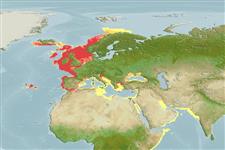Common names from other countries
Environment: milieu / climate zone / depth range / distribution range
Ecologia
; estuarina; intervalo de profundidade 0 - 521 m (Ref. 108343). Temperate; 72°N - 12°N, 19°W - 62°E
Western Indian Ocean, Northeast Atlantic and the Mediterranean. Subtropical.
Length at first maturity / Tamanho / Peso / Idade
Maturity: Lm ? range ? - ? cm Max length : 2.5 cm SHL macho/indeterminado; (Ref. 7882)
Species' maximum length from the Belgian part of the North Sea (Ref. 7882). Inhabit sandbanks and inshore areas (Ref. 96352). Common in near-coastal zone, rarely further than 30 km off the coast. Found buried deep in almost all sediment types but prefer fine-grained to muddy substrates; rare in coarse substrates. Feeds through its long, individually separated and stretchable siphons (Ref. 7882). Known as a surface deposit feeder (Refs. 96214, 96292).
Life cycle and mating behavior
Maturidade | Reprodução | Desova | Ovos | Fecundidade | Larvas
Members of the class Bivalvia are mostly gonochoric, some are protandric hermaphrodites. Life cycle: Embryos develop into free-swimming trocophore larvae, succeeded by the bivalve veliger, resembling a miniature clam.
Degraer, S., J. Wittoeck, W. Appeltans, K. Cooreman, T. Deprez, H. Hillewaert, K. Hostens, J. Mees, E. Vanden Berghe and M. Vincx. 2006. (Ref. 7882)
Categoria na Lista Vermelha da IUCN (Ref. 130435)
Categoria CITES (Ref. 108899)
Not Evaluated
Not Evaluated
Utilização humana
| FishSource |
Ferramentas
Fontes da internet
Estimates based on models
Preferred temperature
(Ref.
115969): 6.7 - 13.1, mean 8.8 (based on 495 cells).
Resiliência
Elevada, tempo mínimo de duplicação da população menor que 15 meses (K=1.22).
Vulnerabilidade
Low vulnerability (10 of 100).
Categoria de preço
Unknown.
